CDL Practice Tests: Flatbed Cargo Securement
Choose A Section:
Go!When securing metal coils in a sided vehicle without anchor points:
- Use friction mats
- Follow general cargo securement requirements
- All of these apply
- Use locking and bracing
Securing Coils Transported in a Sided Vehicle or Intermodal Container without Anchor Points
To prevent metal coils from moving horizontally and/or tipping:
Follow general cargo securement requirements
Secure the coils using:
- Blocking and bracing
- Friction mats
- A combination of these.
How many anchor points should be used to secure an intermodal container on a chassis vehicle?
- 2 latches in the front and 2 in the middle.
- 2 latches in the middle, and 2 at the rear.
- 4 latches total, anywhere on the trailer.
- 2 latches each at or near both the front and rear.
Secure the front and rear of the container independently.
- 2 latches on the chassis engage anchor points towards or at the front of the container.
- 2 latches on the chassis engage anchor points towards or at the rear of the container.
To prevent rolling, how many points of contact are required, at minimum, for a boulder resting on a rounded or partially rounded side?
- 3
- 5
- 4
- 2
Requirements
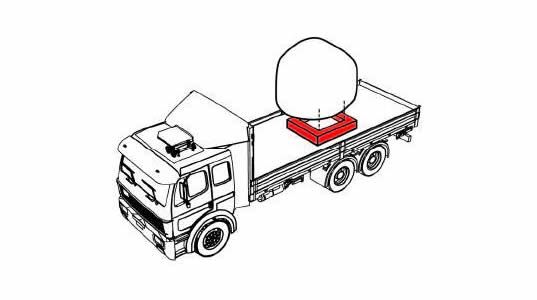
If the flattest side of the boulder is rounded or partially rounded, place the boulder in a crib made of hardwood fixed to deck of vehicle.
Boulder should rest on both deck and timber, with at least 3 well-separated points of contact that prevent rolling in any direction.
When loading and securing a boulder, it should be:
- Supported on at least 2 pieces of 4in x 4in hardwood blocking, extending the full width of the boulder.
- All of these are requirements.
- Placed on the vehicle with its largest or flattest side down.
- Placed on symmetrical hardwood blocking that extends 3/4 of the length of the boulder.
Requirements
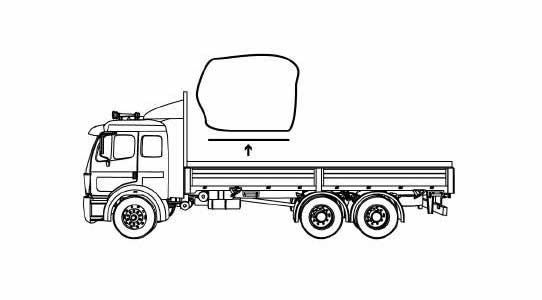
Place each boulder on the vehicle with its flattest and/or largest side down.
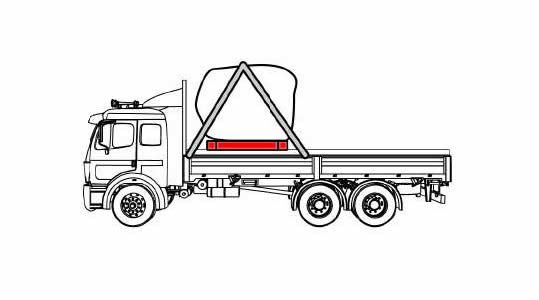
Support each boulder on at least two pieces of hardwood blocking (at least 10 cm x 10 cm (4 x 4 in) that extend the full width of the boulder.
Place hardwood blocking pieces as symmetrically as possible under the boulder so they support at least 3/4 of the length of the boulder.
To secure a cubic-shaped boulder, how many tiedowns are required, at minimum?
- 2
- 1
- 3
- 5
Special Circumstances: Securing a Cubic-Shaped Boulder
The securement of a cubic-shaped boulder must meet these requirements in addition to the other large boulder requirements in Section 13.
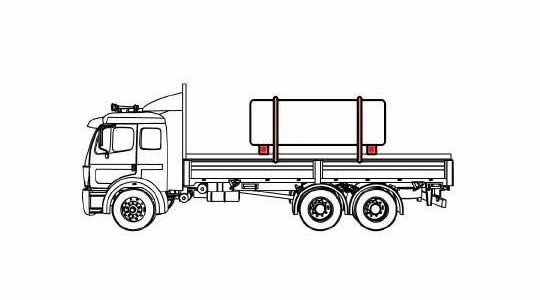
Secure each boulder individually with at least two chain tiedowns placed side-to-side across the vehicle.
Place tiedowns as closely as possible to the hardwood blocking used to support the boulder.
What is the Aggregate WLL of the securement system for a load secured with 7 tiedowns: 3 rated at WLL of 4,000 lbs, 2 at 6,500, and 1 at 8,000?
- 16,500 lbs
- 33,000 lbs
- 10,000 lbs
- 8,250 lbs
How do you calculate Aggregate Working Load Limit for tiedowns?
To calculate Aggregate Working Load limit, add together:
- 50% of the WLL of each end section of a tiedown that is attached to an anchor point.
- 50% of the WLL of each end section that is attached to the cargo
When securing building materials, how many tiedowns are required for top tier bundles longer than 5 ft?
- 1
- 0
- 2
- It depends on weight
Tiedowns over the top tier of bundles with a minimum of 2 tiedowns over each top bundle longer than 1.52 m (5 ft).
In terms of cargo securement, what is a 'well'?
- A rail along the side of a vehicle that protects the side of the vehicle from impacts.
- A device placed between the deck of a vehicle and car or between articles of cargo, intended to provide greater friction than exists naturally between these surfaces.
- The depression formed between two cylindrical articles when they are laid with their eyes horizontal and parallel against each other.
- A female housing fixed to the side or ends of a vehicle to receive a stake or peg, and may also be used as an anchor point.
Well:
The depression formed between two cylindrical articles when they are laid with their eyes horizontal and parallel against each other.
Which of these is specifically prohibited when securing crushed or flattened vehicles?
- Wire rope.
- Synthetic webbing.
- Containment walls.
- Chains.
Securement Requirements
Transport flattened or crushed vehicles so that:
- Cargo does not shift while in transit AND
- Loose parts from the flattened vehicles do not dislodge and fall from the transport vehicle
Do not use synthetic webbing to secure vehicles.
When calculating directional forces, 'g' is expressed as:
- The maximum load that may be applied to a component of a cargo securement system during normal service, usually assigned by the manufacturer of the component.
- The maximum load that may be applied to a component of a cargo securement system during normal service, usually assigned by the manufacturer of the component.
- The acceleration due to gravity, 9.823 m/sec2 (32.2 ft/sec2). For cargo securement purposes it is expressed as a percentage of cargo weight, i.e. .5g is 50% of force of gravity or 50% of cargo weight.
- The summation of the working load limits or restraining capacity of all devices used to secure an article on a vehicle.
g:
The acceleration due to gravity, 9.823 m/sec2 (32.2 ft/sec2). For cargo securement purposes it is expressed as a percentage of cargo weight, i.e. .5g is 50% of force of gravity or 50% of cargo weight.
About The Flatbed Cargo Securement CDL Manual
Studying the flatbed cargo securement CDL manual is not a requirement for getting your CDL permit or license. It is required knowledge for flatbed drivers.
Some questions you should be able to answer for flatbed cargo securement:
- What is the minimum Working Load Limit of a tiedown used to secure logs?
- What is the minimum weight of a shipment of paper rolls that would require specific securement requirements?
- When securing concrete pipe over 45 inches loaded crosswise, which direction must the tiedowns on the front half of the load run?
- What is a cab shield?
- When securing concrete pipe over 45 inches loaded crosswise, which direction must the tiedowns on the rear half of the load run?
- What is a dunnage bag?
- Who is responsible for inspecting securing devices and cargo within the first 50 miles?
- How many tiedowns are required on a stack of shortwood loaded crosswise?
- What is the minimum working load limit of each tiedown used to secure crushed or flattened vehicles?
- Define 'bolster'
- What is a hook-lift container?
- When a tiedown is attached directly to the cargo, what is the ideal angle where it attached to the vehicle?
What is a securing device?
Any device specifically manufactured to attach or secure cargo to a vehicle or trailer:
- Synthetic Webbing
- Chain
- Wire rope
- Manila rope
- Synthetic rope
- Steel strapping
- Clamps and latches
- Blocking
- Front-end structure
- Grab hooks
- Binders
- Shackles
- Winches
- Stake pockets
- D-rings
- Webbing ratchet
- Bracing
- Friction mat
What is a tiedown?
A combination of securing devices that forms an assembly that:
- Attaches cargo to, or restrains cargo on a vehicle.
- Is attached to anchor point(s).
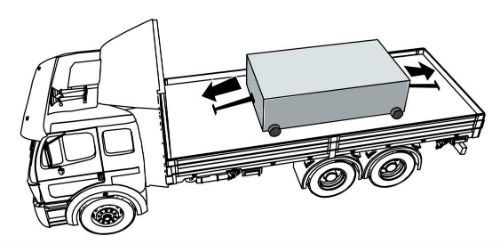
Some tiedowns are attached to the cargo and provide direct resistance to restrain the cargo from movement.
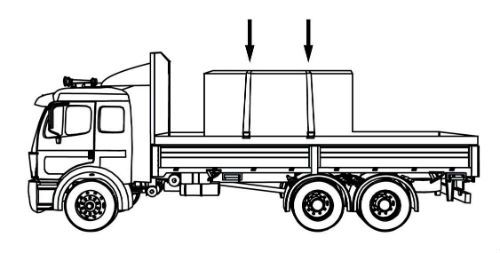
Some tie-downs pass over or through the cargo. They create a downward force that increases the effect of friction between the cargo and the deck. This friction restrains the cargo.
 Related Cargo Securement Terms That Every Driver Should Know:
Related Cargo Securement Terms That Every Driver Should Know:
-
Tiedown:
A combination of securing devices which form an assembly that attaches cargo to, or restrains cargo on, a vehicle or trailer, and is attached to anchor point(s).
-
Contained:
Cargo is contained if it fills a sided vehicle, and every article is in contact with or sufficiently close to a wall or other articles so that it cannot shift or tip if those other articles are also unable to shift or tip.
-
Blocking:
A structure, device, or another substantial article placed against or around an article to prevent horizontal movement of the article.
How should tiedowns be attached?
Tiedowns can be used in two ways:
-
Attached to the cargo:
- Tiedowns attached to the vehicle and attached to the cargo.
- Tiedowns attached to the vehicle, pass through or aroundan article of cargo, and then are attached to the vehicle again.
-
Pass over the cargo:
- Tiedowns attached to the vehicle, passed over the cargo, and then attached to the vehicle again.
Tiedown placement:

Place the tiedown as close as possible to the spacer.
Position the tiedowns as symetrically as possible over the length of the article.

Position the tiedowns to preserve the integrity of the article.







 TT On Facebook
TT On Facebook